Ponderosa Pines... can they really make good bonsai?
+15
coh
xuan le
Poink88
Walter Pall
JimLewis
Fore
peter keane
Rob Kempinski
bonsaisr
crust
mike page
drgonzo
marcus watts
LSBonsai
jgeanangel
19 posters
Page 1 of 2
Page 1 of 2 • 1, 2 
 Ponderosa Pines... can they really make good bonsai?
Ponderosa Pines... can they really make good bonsai?
...over the past several years I have been watching the forums, mags, blogs, etc...for "quality" examples of Ponderosa Pine bonsai. I have seen hundreds, if not thousands of photos but to this day I still have really only seen one example that I personally thought worked well as a bonsai....and that tree doesn't even live in North America...its Walter's. Perhaps there have been a couple others out there that mostly worked but they were very large trees....bigger than most people can handle in a personal collection.
The problem as I see it is the foliage. The needles are just tooooo long, odd-colored and do not reduce well. They often have beautifully gnarly trunks and bark but the foliage is almost always out of scale and branches never seem to develop the ramification of other pine species. I recently looked at a thread or blog post where somebody was showing off their Ponderosa that they had been working on for the last decade and to my eye the tree was unchanged...yeah some branches had been wired but the tree still looked nothing like a bonsai/tree...
I see people spending reasonably large sums of money on these trees that are most likely never going to look like a bonsai or a tree. There are a multitude of collectors that are willing to sell you one right now! But, I have to wonder is Ponderosa a species that is generally good for bonsai. Am I alone in this thinking? Has anybody successfully reduced the needles on a ponderosa (and you are willing to share pictorial evidence) so that they are in proportion with the trunk and branches? Have you bought one of these trees and now you find yourself frustrated because its just not developing like you hoped it might? You've put years into training and the tree still looks like something growing on the side of the road because the branches do not ramify? Where are all the pics of the trees that have been collected in Colorado, or other Western states, over the last several decades??
Obviously we are all in control of how we spend our own money and what material we choose to work on but I wonder how many people were coaxed into buying this species, maybe because it was labeled yamadori or bc some of the big names out there that promote the species, and now are not satisfied with the characteristics of this species??
I would love to hear some of your personal thoughts and experiences with Ponderosa pine.
If you have pics of ones that you think work well as bonsai I would love to see them!!
Thanks,
John
The problem as I see it is the foliage. The needles are just tooooo long, odd-colored and do not reduce well. They often have beautifully gnarly trunks and bark but the foliage is almost always out of scale and branches never seem to develop the ramification of other pine species. I recently looked at a thread or blog post where somebody was showing off their Ponderosa that they had been working on for the last decade and to my eye the tree was unchanged...yeah some branches had been wired but the tree still looked nothing like a bonsai/tree...
I see people spending reasonably large sums of money on these trees that are most likely never going to look like a bonsai or a tree. There are a multitude of collectors that are willing to sell you one right now! But, I have to wonder is Ponderosa a species that is generally good for bonsai. Am I alone in this thinking? Has anybody successfully reduced the needles on a ponderosa (and you are willing to share pictorial evidence) so that they are in proportion with the trunk and branches? Have you bought one of these trees and now you find yourself frustrated because its just not developing like you hoped it might? You've put years into training and the tree still looks like something growing on the side of the road because the branches do not ramify? Where are all the pics of the trees that have been collected in Colorado, or other Western states, over the last several decades??
Obviously we are all in control of how we spend our own money and what material we choose to work on but I wonder how many people were coaxed into buying this species, maybe because it was labeled yamadori or bc some of the big names out there that promote the species, and now are not satisfied with the characteristics of this species??
I would love to hear some of your personal thoughts and experiences with Ponderosa pine.
If you have pics of ones that you think work well as bonsai I would love to see them!!
Thanks,
John
jgeanangel- Member
 Re: Ponderosa Pines... can they really make good bonsai?
Re: Ponderosa Pines... can they really make good bonsai?
Here are a couple from Ryan Neil which I think are gorgeous trees:


Are the needles in scale with the trunk? Not really.
Do I think they are stunning trees? Hells yes.
Even if the needles don't reduce further as the tree ramifies (which I seriously doubt will be the case), they are gorgeous trees, well designed, with rugged and inspiring trunks. Even if they never end up having the proportions of a Japanese pine, I think it is easy to appreciate them for what they are.
I think it is hard to say that these are not one their way to becoming beautiful bonsai, but it is perfectly fine if you don't like them due to personal preference.
I know you highlighted the word generally, asking if they are "generally good for bonsai" like, say, a chinese juniper or a black pine, which both have all around outstanding characteristics. To that I would say no, they are not. Like many native species (all western junipers, larch, thuja, redwoods, etc, etc.), the challenge lies in finding quality collected material, and treating it properly. Otherwise leave it alone.


Are the needles in scale with the trunk? Not really.
Do I think they are stunning trees? Hells yes.
Even if the needles don't reduce further as the tree ramifies (which I seriously doubt will be the case), they are gorgeous trees, well designed, with rugged and inspiring trunks. Even if they never end up having the proportions of a Japanese pine, I think it is easy to appreciate them for what they are.
I think it is hard to say that these are not one their way to becoming beautiful bonsai, but it is perfectly fine if you don't like them due to personal preference.
I know you highlighted the word generally, asking if they are "generally good for bonsai" like, say, a chinese juniper or a black pine, which both have all around outstanding characteristics. To that I would say no, they are not. Like many native species (all western junipers, larch, thuja, redwoods, etc, etc.), the challenge lies in finding quality collected material, and treating it properly. Otherwise leave it alone.
LSBonsai- Member
 Re: Ponderosa Pines... can they really make good bonsai?
Re: Ponderosa Pines... can they really make good bonsai?
i think the first picture is nothing special - there is just a single tuft of needles on the ends of some fairly long and very bare branches. Good wiring and a low camera angle help to disguise this. The second tree looks to have shorter branches before the needles start but it may have been found like that rather than improved to that stage.
These both appear to be newly styled trees though ? so it bares no true relevence to the original question as to do they ramify and improve with time or just stay like this with poor density (especially if seen from above i expect). Top be fair any competent artist could take a collected tree like these and wire the canopy to look domed ready for sale - it doesnt mean the tree will pay you back after 10 or 15 years hard work with a stunning dense and in scale image.
There are many european pines the same - rubbish needles, thick branches and huge cones. Luckily they are not getting sold to the un-suspecting hobbyist though. (yet!)
Excelent topic, it need more conversation on what doesnt make a good bonsai
Cheers Marcus
These both appear to be newly styled trees though ? so it bares no true relevence to the original question as to do they ramify and improve with time or just stay like this with poor density (especially if seen from above i expect). Top be fair any competent artist could take a collected tree like these and wire the canopy to look domed ready for sale - it doesnt mean the tree will pay you back after 10 or 15 years hard work with a stunning dense and in scale image.
There are many european pines the same - rubbish needles, thick branches and huge cones. Luckily they are not getting sold to the un-suspecting hobbyist though. (yet!)
Excelent topic, it need more conversation on what doesnt make a good bonsai
Cheers Marcus

marcus watts- Member
 Re: Ponderosa Pines... can they really make good bonsai?
Re: Ponderosa Pines... can they really make good bonsai?
John
I feel its just a mater of personal aesthetics, I've seen the Ponderosas on Golden arrows website and thought some looked good others not so much. This sort of trade off is all part of dealing with the "fringe" species that are cultivated and trained as bonsai but may have a design problem thats inherent to the species, foliage reduction, root disturbance issues and the like. We trade those features off and in the case of Ponderosa you can get some pretty funky twists and turns in the trunk and some really cool bark, the trade off is the foliage reduction issue as you mentioned.
The idea I think is to try to get starting material that emphasizes one of the strong points to such a degree that the week points can be accepted a bit better. I do a lot of work with American Beech, there we have a foliage issue, but with good starting material the good stuff can out-way the bad stuff. I think thats what makes Walters tree so nice.
I'm sure you could take any of those Ponderosas Andrew has, figure out a way to plant it on a rock, and you'd make something righteous out of it
Best
-Jay
I feel its just a mater of personal aesthetics, I've seen the Ponderosas on Golden arrows website and thought some looked good others not so much. This sort of trade off is all part of dealing with the "fringe" species that are cultivated and trained as bonsai but may have a design problem thats inherent to the species, foliage reduction, root disturbance issues and the like. We trade those features off and in the case of Ponderosa you can get some pretty funky twists and turns in the trunk and some really cool bark, the trade off is the foliage reduction issue as you mentioned.
The idea I think is to try to get starting material that emphasizes one of the strong points to such a degree that the week points can be accepted a bit better. I do a lot of work with American Beech, there we have a foliage issue, but with good starting material the good stuff can out-way the bad stuff. I think thats what makes Walters tree so nice.
I'm sure you could take any of those Ponderosas Andrew has, figure out a way to plant it on a rock, and you'd make something righteous out of it
Best
-Jay
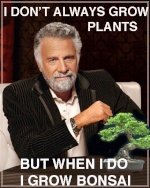
drgonzo- Member
 Re: Ponderosa Pines... can they really make good bonsai?
Re: Ponderosa Pines... can they really make good bonsai?
marcus watts wrote:These both appear to be newly styled trees though ? so it bares no true relevence to the original question as to do they ramify and improve with time or just stay like this with poor density (especially if seen from above i expect).
Fair enough, and good points made. I am still one the defense, though. I do not think ponderosa should be discarded as a species with outstanding potential. Even if the trees will never ramify, and never produce an in-scale image, they are still incredibly valuable material. Practically the entire value of a tree is in its trunk and (for pines) the bark. Ponderosa have both of these features in abundance. Everything else can be changed. I bet there are professionals in Japan who would kill to have a ponderosa like the first one I posted. And they would probably spend 10 years grafting it and growing a new crown.
Perhaps more americans need to start grafting ponderosa. I know Michael Hagedorn is doing it. This is probably necessary if "perfect" bonsai are ever to be made from the species.
And for the record, I am neither american nor do I own a single ponderosa
LSBonsai- Member
 Re: Ponderosa Pines... can they really make good bonsai?
Re: Ponderosa Pines... can they really make good bonsai?
hi a2khalid,
points well made too - but using a ponderossa as a rootstock for better foliage is totally different to growing a ponderosa bonsai. It ceases to be one once the last branch is cut back to the inner graft. The trees will become named or known by the foliage - a white pine top grafted to black pine base is called a white pine afterall, not a black pine. Same with ityogawa foliage on weathered juniper rigida trunks - they sell as ityogawas (and for a lot of money too).
Rigidas are out of fashion atm and many are being transformed to scale foliage to sell, so using these great ponderosa trunks as carriers for black pine foliage may be a way to make the most from them in the future.
also i dont have one, and have never worked with one either.
cheers Marcus
points well made too - but using a ponderossa as a rootstock for better foliage is totally different to growing a ponderosa bonsai. It ceases to be one once the last branch is cut back to the inner graft. The trees will become named or known by the foliage - a white pine top grafted to black pine base is called a white pine afterall, not a black pine. Same with ityogawa foliage on weathered juniper rigida trunks - they sell as ityogawas (and for a lot of money too).
Rigidas are out of fashion atm and many are being transformed to scale foliage to sell, so using these great ponderosa trunks as carriers for black pine foliage may be a way to make the most from them in the future.
also i dont have one, and have never worked with one either.
cheers Marcus

marcus watts- Member
 Re: Ponderosa Pines... can they really make good bonsai?
Re: Ponderosa Pines... can they really make good bonsai?
Thanks for joining the discussion guys! The pictures posted, especially the first one, demonstrate my point perfectly. Amazing trunks and bark but, for me at least, the "tree" is reduced in some way when the foliage becomes part of the overall. And, there is certainly no doubt that Ryan is a gifted artist and as such does his best to minimize the weaknesses and maximize the strengths of the material he styles...beautifully!
I agree that to some extent this is certainly a matter of personal taste. But, I have to wonder if this species doesn't have some kind of mystic about it that may or may not be deserved. I also agree with Marcus about the grafting. Certainly a viable and logical option but a little out of focus for the question.
I will be interested to hear the thoughts of those out there that have been working with this species for several years...are you satisfied with how your tree is developing, have you been able to create ramifications, shorter needles, is the trunk and bark so good that you can forgive the foliage? Would you recommend the species to another hobbyist?
Jay..thanks..it would take a really big rock to pull that off:)
Thanks for talking through this with me guys!
John
I agree that to some extent this is certainly a matter of personal taste. But, I have to wonder if this species doesn't have some kind of mystic about it that may or may not be deserved. I also agree with Marcus about the grafting. Certainly a viable and logical option but a little out of focus for the question.
I will be interested to hear the thoughts of those out there that have been working with this species for several years...are you satisfied with how your tree is developing, have you been able to create ramifications, shorter needles, is the trunk and bark so good that you can forgive the foliage? Would you recommend the species to another hobbyist?
Jay..thanks..it would take a really big rock to pull that off:)
Thanks for talking through this with me guys!
John
jgeanangel- Member
 Re: Ponderosa Pines... can they really make good bonsai?
Re: Ponderosa Pines... can they really make good bonsai?
I have a few Pondos I have been grafting Scots onto. It has been a slow process--years have gone by. Two trees died when I was too quick to chop off the mother foliage. Some trees never seem to accept grafts. when they do take they have grown very slow. I am now weening off the mother foliage on a couple that have taken. All grafts were live grafts (potted seedling scots pines) using the "one-point method". The included shoddy pic is one tree whose graft has been slowly gaining strength while I slowly remove more and more of the mother foliage--the tree will be along time in training before it will look decent to be sure. I have not been able to really get these trees to grow agressively during the process (probably due to my horticultural ineptitude) which may be the key to sucess. So far I have seen Japanese Red pine, Japanese Black pine, Japanese white pine and my Scots grafted on to Pondos (it would be fun to try mugo). I don't know if there is any enduring examples of any well formed grafted trees.a2khalid wrote:marcus watts wrote:These both appear to be newly styled trees though ? so it bares no true relevence to the original question as to do they ramify and improve with time or just stay like this with poor density (especially if seen from above i expect).
Fair enough, and good points made. I am still one the defense, though. I do not think ponderosa should be discarded as a species with outstanding potential. Even if the trees will never ramify, and never produce an in-scale image, they are still incredibly valuable material. Practically the entire value of a tree is in its trunk and (for pines) the bark. Ponderosa have both of these features in abundance. Everything else can be changed. I bet there are professionals in Japan who would kill to have a ponderosa like the first one I posted. And they would probably spend 10 years grafting it and growing a new crown.
Perhaps more americans need to start grafting ponderosa. I know Michael Hagedorn is doing it. This is probably necessary if "perfect" bonsai are ever to be made from the species.
And for the record, I am neither american nor do I own a single ponderosa
crust- Member
 Re: Ponderosa Pines... can they really make good bonsai?
Re: Ponderosa Pines... can they really make good bonsai?
here is one opf the grafted Pondos
[url=https://servimg.com/view/17149371/8][img
[url=https://servimg.com/view/17149371/8][img
crust- Member
 Ponderosa Pine
Ponderosa Pine
I'm afraid I have to agree with most of the objections. I have always considered Ponderosa a guy's tree, just as many would consider Serissa a veibishe (suitable for housewives) tree. There is a beautiful Ponderosa in the National Bonsai & Penjing Museum (Washington, DC). It was donated by the US Forest Service. I don't know the measurements, but it is LARGE. A museum piece, like "Guernica," not for somebody's home collection.
Iris
Iris
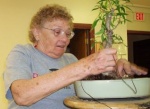
bonsaisr- Member
 Re: Ponderosa Pines... can they really make good bonsai?
Re: Ponderosa Pines... can they really make good bonsai?
[quote="crust"]
thats excelent to read from some first hand observations. the first thought that leaps at me from your experience is the vigour is unbalanced - scotts pines are usually very vigourous trees on their own roots producing plenty of extension growth and lots of buds, just like a black pine they grow fast if left to it. For these grafts to be extremely slow suggests the sap flow and internal workings of the ponderosa is running at a different (slower) speed, so the grafts are not getting the vigour and energy they require to behave naturally.
the only way an experimental grower could try to improve this would be to graft vigourous roots under the soil - so top and bottom match using the trunk as the carrier. Even this may not work as the trunk capillaries may not take the extra energy from the new 'fast' roots. Once you've spent years doing this though you would have a stunning collection of black pines grown from seed.
a2khalid wrote:
I have a few Pondos I have been grafting Scots onto. It has been a slow process--years have gone by. Two trees died when I was too quick to chop off the mother foliage. Some trees never seem to accept grafts. when they do take they have grown very slow. I am now weening off the mother foliage on a couple that have taken. All grafts were live grafts (potted seedling scots pines) using the "one-point method". The included shoddy pic is one tree whose graft has been slowly gaining strength while I slowly remove more and more of the mother foliage--the tree will be along time in training before it will look decent to be sure. I have not been able to really get these trees to grow agressively during the process (probably due to my horticultural ineptitude) which may be the key to sucess. So far I have seen Japanese Red pine, Japanese Black pine, Japanese white pine and my Scots grafted on to Pondos (it would be fun to try mugo). I don't know if there is any enduring examples of any well formed grafted trees.
thats excelent to read from some first hand observations. the first thought that leaps at me from your experience is the vigour is unbalanced - scotts pines are usually very vigourous trees on their own roots producing plenty of extension growth and lots of buds, just like a black pine they grow fast if left to it. For these grafts to be extremely slow suggests the sap flow and internal workings of the ponderosa is running at a different (slower) speed, so the grafts are not getting the vigour and energy they require to behave naturally.
the only way an experimental grower could try to improve this would be to graft vigourous roots under the soil - so top and bottom match using the trunk as the carrier. Even this may not work as the trunk capillaries may not take the extra energy from the new 'fast' roots. Once you've spent years doing this though you would have a stunning collection of black pines grown from seed.

marcus watts- Member
 Re: Ponderosa Pines... can they really make good bonsai?
Re: Ponderosa Pines... can they really make good bonsai?
The short answer is "Yes," Ponderosa Pines can make great bonsai.
The long answer entails several points.
1. Not all trees have to look like Japanese Black Pine or Red Pine
2. Long needles are not a problem on a big tree
3. Other features of a bonsai (bark, trunk shape, pot arrangement) can make PP just as redeeming (and desirable) as other pines.
4. Cultivation practices can reduce needle size if desired
5. There are many nice Ponderosa Pine bonsai trees in the USA. Did you happen to see the Ponderosa Pine by Scott Elser that won the best Evergreen tree award at the last US National Exhibition? Pretty darn nice! Andy Smith, Jack Douthitt, Warren and Sharon Hill, and Jerome Cushman all displayed nice PPs at the 1st US National Exhibition. Marty Schmalenberg, Andy Smith, Doug and Pam Hampel (had 2 on display at the ABS Learning Seminar in 2006 in Saratoga Springs
We don't have any here in Florida (too hot, no mountains) but I have seen other nice ones at various venues, for instance at the US National Arboretum, at Dan Robinson's nursery in Washington State, and at the World Bonsai Convention in DC in 2005 where I believe Sara Rayner displayed one (if my memory serves me correctly, and I believe she later told me it expired - drat.) Just because you don't see them on the internet doesn't mean they are not out there.
Here is one that Marty Schmalenberg exhibited at the ABS Learning Seminar in 2006 in Saratoga Springs.

The long answer entails several points.
1. Not all trees have to look like Japanese Black Pine or Red Pine
2. Long needles are not a problem on a big tree
3. Other features of a bonsai (bark, trunk shape, pot arrangement) can make PP just as redeeming (and desirable) as other pines.
4. Cultivation practices can reduce needle size if desired
5. There are many nice Ponderosa Pine bonsai trees in the USA. Did you happen to see the Ponderosa Pine by Scott Elser that won the best Evergreen tree award at the last US National Exhibition? Pretty darn nice! Andy Smith, Jack Douthitt, Warren and Sharon Hill, and Jerome Cushman all displayed nice PPs at the 1st US National Exhibition. Marty Schmalenberg, Andy Smith, Doug and Pam Hampel (had 2 on display at the ABS Learning Seminar in 2006 in Saratoga Springs
We don't have any here in Florida (too hot, no mountains) but I have seen other nice ones at various venues, for instance at the US National Arboretum, at Dan Robinson's nursery in Washington State, and at the World Bonsai Convention in DC in 2005 where I believe Sara Rayner displayed one (if my memory serves me correctly, and I believe she later told me it expired - drat.) Just because you don't see them on the internet doesn't mean they are not out there.
Here is one that Marty Schmalenberg exhibited at the ABS Learning Seminar in 2006 in Saratoga Springs.

Last edited by Rob Kempinski on Tue Jan 24, 2012 11:55 pm; edited 1 time in total

Rob Kempinski- Member
 Re: Ponderosa Pines... can they really make good bonsai?
Re: Ponderosa Pines... can they really make good bonsai?
I love ponderosa pine trunks, but, not the foliage. too long and airy for me. I've grafted scots and japanese red pine to it with good success. I've not seen my scots shoots slow down in vigor as a result of grafting. the shoots are budding like they were on their own rootstock. I've tried mugo scions to one ponderosa. The mugos didn't survive. I'm certain that it was a matter of how I prepared the scion wood, rather than incompatibility of the two types. I'm going to be trying that one again in march of this year.
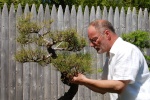
peter keane- Member
 Re: Ponderosa Pines... can they really make good bonsai?
Re: Ponderosa Pines... can they really make good bonsai?
I totally agree with Rob. PPs can make beautiful bonsai along with those caveats mentioned. I have two, but are still in their growing boxes and I have another yr or two before I can start work. But I've been told by Ryan N., Andy Smith and others here in Chicago that once you get them healthy and wired, they do back bud. So a more compact tree can be done. And there are horticultural ways to reduce the needles. But the needle length in the two pictured trees doesn't bother me at all. I think they are beautiful in their own way. Not a big believer in grafting...to me, and I've gotten into heated discussions before about this so this is just mho: If you graft on new foliage, then it's not a "true" PP anymore. Same goes for grafting shimpaku onto RMJs. Just goes against my grain even though I know alot of people do this and it makes the tree more valuable...just not to me 
Chris
Chris

Fore- Member
 Re: Ponderosa Pines... can they really make good bonsai?
Re: Ponderosa Pines... can they really make good bonsai?
Thanks for your thoughts Chris... You are certainly correct in that it is all about personal preference!!
Fore wrote: But I've been told by Ryan N., Andy Smith and others here in Chicago that once you get them healthy and wired, they do back bud. So a more compact tree can be done.
I have also heard and read this for years, but I wonder why there are not any examples out there of PP with nice ramification and short needles??? With the 100's if not 1000's of PP that have been collected, and sold to hobbyist in the last couple of decades, it sure seems that these characteristics would be showing up in lots of these trees by now.
Makes me wonder if most of these comments about PP ability to bud back and ramify are more marketing and/or suspicions then not based on successful experiences....but it looks like I am beating a dead horse now!
John
jgeanangel- Member
 Re: Ponderosa Pines... can they really make good bonsai?
Re: Ponderosa Pines... can they really make good bonsai?
Well, the probably wouldn't do well where we live, anyway, john -- at least not in the long run.

JimLewis- Member
 Re: Ponderosa Pines... can they really make good bonsai?
Re: Ponderosa Pines... can they really make good bonsai?
Here is how David Yedwab from USA a couple of years ago saw my ponderosas showing (normal for me) strength with candles which I had to pinch back later. Also see the three better ones of several ponderosas. And see the color. It is not photopshopped but for real, ask David. Every American seeing them cannot believe that these are ponderosas and insists that they must be some European black pine or similar. Well, they never are that green in Colorady, that's for sure.
What do I do? Just about the opposite of most: very strong watering every day, sometimes two waterings a day, very strong feeding with lots of nitrogen, full sunshine, very coarse substrate, no winter protection, full sun all day. Read Larry Jackle's book.
Why ponderosas usually don't look like this in America? My take is because folks don't do what I do.
Why does Marco Invernizzi say that ponderosas are not good for bonsai? Because they look in no way like a good Japanese black pine. This is what he answered when I sent him these photos. He said, that this just is not good enough. Well, what can I say? An American Western girl does not look like a Japanese girl in a kimono. So is that bad, not good enough? An orchid does not look like a rose. How bad is that!
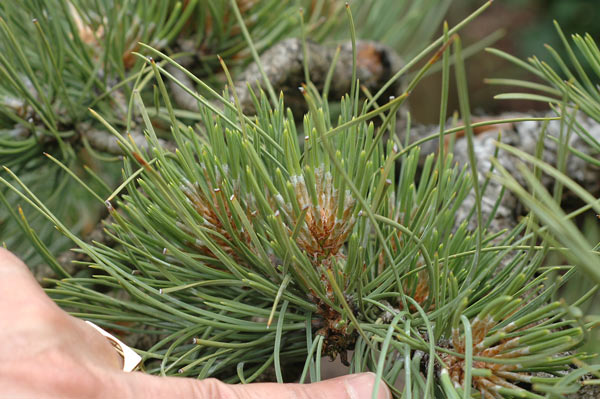
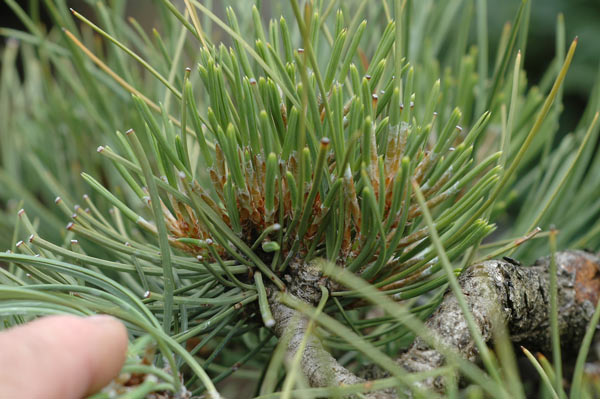
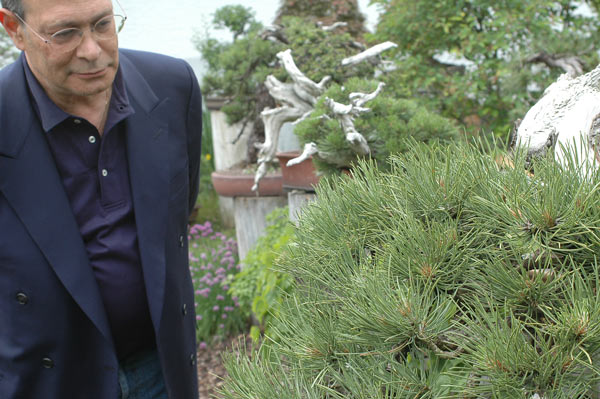

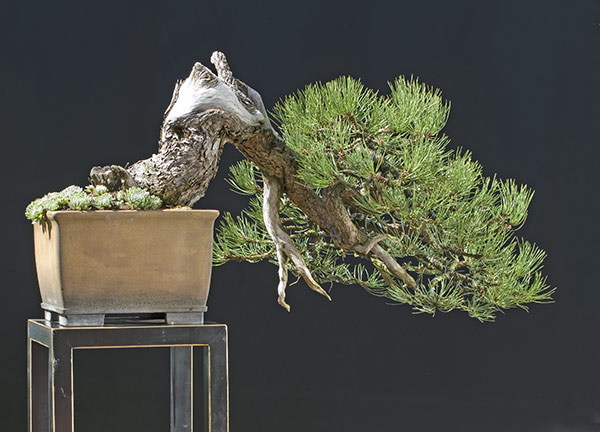

What do I do? Just about the opposite of most: very strong watering every day, sometimes two waterings a day, very strong feeding with lots of nitrogen, full sunshine, very coarse substrate, no winter protection, full sun all day. Read Larry Jackle's book.
Why ponderosas usually don't look like this in America? My take is because folks don't do what I do.
Why does Marco Invernizzi say that ponderosas are not good for bonsai? Because they look in no way like a good Japanese black pine. This is what he answered when I sent him these photos. He said, that this just is not good enough. Well, what can I say? An American Western girl does not look like a Japanese girl in a kimono. So is that bad, not good enough? An orchid does not look like a rose. How bad is that!







Walter Pall- Member
 Re: Ponderosa Pines... can they really make good bonsai?
Re: Ponderosa Pines... can they really make good bonsai?
Walter Pall wrote:An American Western girl does not look like a Japanese girl in a kimono. So is that bad, not good enough? An orchid does not look like a rose. How bad is that!
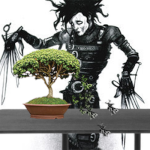
Poink88- Member
 Re: Ponderosa Pines... can they really make good bonsai?
Re: Ponderosa Pines... can they really make good bonsai?
Excellent post and beautiful trees, and great inspirations of what can be attained from PP's Walter! And sorry too, I forgot to mention your name above as you also told me the same  My memory is just not as good as it used to be lol
My memory is just not as good as it used to be lol
Btw, that last tree picture looks very similar to how I styled the smaller PP I got from you and Jim. Can't wait to get it repotted into a bonsai pot ;D It's going to be one of my best trees I think if I can get it as healthy as those!
Btw, that last tree picture looks very similar to how I styled the smaller PP I got from you and Jim. Can't wait to get it repotted into a bonsai pot ;D It's going to be one of my best trees I think if I can get it as healthy as those!

Fore- Member
 Re: Ponderosa Pines... can they really make good bonsai?
Re: Ponderosa Pines... can they really make good bonsai?
Growing Ponderosa in Europe
by Walter Pall
When I first got in touch with Ponderosa Pines in America I listened to all sorts of advice of how to take care of them. The advice I got in a nutshell: water sparingly, do not expose to rain in winter, keep very dry, feed very little, almost no nitrogene as it will cause very long needles. In more than ten years of caring intensively for more than a handful of Ponderosa Pines in my garden in Germany I can say that obviously the opposite of the general advice works much better. I can say this comparing the looks and vigor of my trees with just about all Ponderosa Pines that I see in America on may many trips. I have seen too many trees which were not in good shape at all and obviously going downhill. Most Americans coming to my garden could not believe that what they say were Ponderosa pines. They mistake them for black pines normally. So it cannot all be wrong what I am doing.
What do I do?
Water: It is correct that the Ponderosa Pine is able to survive long periods of draught, but it clearly grows much better with normal watering which compares to other pines. A prerequisite is a very well draining substrate. Then one can and even should water every day heftily. If the right soil mixture is used one can leave the pines in one location all year round, also during long rainy periods. It sometimes rains for ten days in a row where I live and the ponderosas afterwards look healthier than ever.
The chemical contents of the water don’t seem to matter. If water with a high concentration of calcium is used over extended periods of time it does not do harm to the trees but a grey film on the needles may well be the result.
Long needles are the result of a combination of much water and feeding as advised here. Therefore a ‘finished’ bonsai will finally get less water and feed. But this only after more than a decade in development.
Repotting: Collected trees can stay in the same substrate for a very long time. But this is only true if they stand in modern bonsai substrate! The soil from the natural habitat must be removed as soon as possible. Coming to think of it the main difference between my ponderosas and the ones that I see in America is that mine had to be bare rooted at import and that the American ones usually stand in the soil of their habitat surrounded by modern substrate. Afterthis original soil is removed it often is not necessary to repot for more than five years. The best time is spring. When repotting one should use the chance to remove old soil from the root ball which still might be there. Collected trees should not be root pruned for a long time. The roots should be left in the full length as the tree was collected. If necessary they can be somehow crammed in a spiral form into the container. Collected trees often have a very firm root ball which has awkward shapes. It has the shape of the pocket in the rock where the tree used to grow. Sometimes it is difficult to plant this root ball into a decent bonsai pot. The ancient roots cannot be bent without severe damage. Therefore the bonsai enthusiast is advised to first of all try to find out into what sort of container the tree will fit at all before the crown is styled. It does not make sense to style a good crown over many years, only to find out that the pine never will fit into the forseen kind of container.
Soil: The substrate must be very well draining and aeriating. It should be slightly acid to neutral, sandy with no or almost no organic content. Andy Smith recommends 70% coarse Akadama or similar plus 30 % bark mulch. Other bonsai enthusiasts work with granite gravel with added organic contents. Very good results were achieved in Central Europe with a mixture of 85% coarse pumice or lava or baked loam plus 15% rough peat. With all these substrates it is quite important to know that they contain almost no feed. It is therefore indispensable to feed a lot and often.
Cutting and pinching: As with all pines one must never cut back a branch to where no or very few needles are left. The branch will die inevitably. One can expect that a Ponderosa Pine will develop several buds on the tips, but they hardly ever bud back into old wood. Therefore one should avoid cutting off branches as far as possible and rather work with what is there and create a good crown with the existing needle whirls.
For getting shorter needles one can also practice the following method: In May with all whirls the needles are cut back to the length that one would have liked. The buds must remain intact. These buds will develop candles which have a bit shorter needles, because they get somewhat less energy from the shortened needles. The tips of the needles will look slightly ugly though for one season.
In late summer the buds for next year appear. With Ponderosa Pines these are very often the rhombical flower buds all over the tree. Flowers should be avoided. In fall the rhombs are rubbed off in such a way that the very center, which is the normal needle bud stays. On very healthy trees one can also take off the whole flower bud.
Feeding: Regular feeding throughout the vegetation period is a must. Good results are achieved with organic as well as anorganic feeds with medium to high nitrogen content. Strong feeding in fall stimulates the development of buds, even several buds on one whirl. In spring and summer slightly less feeding is appropriate to avoid too long needles. But during development of a bonsai one can well work with very high nitrogen contents in organic feed. Long needles will create a lot of energy which leads to lots of backbudding. Later, when the bonsai is ‘finished’ one can feed less.
Location: Ponderosa Pines want a lot of sunshine. A location in full sun is just right. Even in very hot and sunny summers they grow very well as long as they are watered well. In summer at temperatures of above 30°C partial half shade is required when one cannot water fully every day. When substrate is used that is not very well draining it is important to protect the tree from long rain periods. In most areas a location on a wall facing to southeast is good. The rain, which usually comes from the west will be kept away by the wall. If the recommended kind of soil mixture is used it is possible to leave the Ponderosa Pine at the spot even in long rainy periods.
Hardiness: The pine is hardy to very hardy (zone 5b). It is jeopardized by late frosts. Recently collected trees need good protection for several years before they are fully established. In winter they should be protected from permanent rain. On the other hand it is a big mistake to keep them too dry in winter.
Diseases: The Ponderosa Pine is usually free of diseases and critters as bonsai. Sometimes one finds aphids which can be removed with the fingers. One can spray with oil emulsion in late winter as preventive measure. Collected pines with much deadwood can contain bores which can become quite dangerous. Small mistle toes in the branches are not cute but reason for immediate alarm. They will kill the tree and there is no cure.
by Walter Pall
When I first got in touch with Ponderosa Pines in America I listened to all sorts of advice of how to take care of them. The advice I got in a nutshell: water sparingly, do not expose to rain in winter, keep very dry, feed very little, almost no nitrogene as it will cause very long needles. In more than ten years of caring intensively for more than a handful of Ponderosa Pines in my garden in Germany I can say that obviously the opposite of the general advice works much better. I can say this comparing the looks and vigor of my trees with just about all Ponderosa Pines that I see in America on may many trips. I have seen too many trees which were not in good shape at all and obviously going downhill. Most Americans coming to my garden could not believe that what they say were Ponderosa pines. They mistake them for black pines normally. So it cannot all be wrong what I am doing.
What do I do?
Water: It is correct that the Ponderosa Pine is able to survive long periods of draught, but it clearly grows much better with normal watering which compares to other pines. A prerequisite is a very well draining substrate. Then one can and even should water every day heftily. If the right soil mixture is used one can leave the pines in one location all year round, also during long rainy periods. It sometimes rains for ten days in a row where I live and the ponderosas afterwards look healthier than ever.
The chemical contents of the water don’t seem to matter. If water with a high concentration of calcium is used over extended periods of time it does not do harm to the trees but a grey film on the needles may well be the result.
Long needles are the result of a combination of much water and feeding as advised here. Therefore a ‘finished’ bonsai will finally get less water and feed. But this only after more than a decade in development.
Repotting: Collected trees can stay in the same substrate for a very long time. But this is only true if they stand in modern bonsai substrate! The soil from the natural habitat must be removed as soon as possible. Coming to think of it the main difference between my ponderosas and the ones that I see in America is that mine had to be bare rooted at import and that the American ones usually stand in the soil of their habitat surrounded by modern substrate. Afterthis original soil is removed it often is not necessary to repot for more than five years. The best time is spring. When repotting one should use the chance to remove old soil from the root ball which still might be there. Collected trees should not be root pruned for a long time. The roots should be left in the full length as the tree was collected. If necessary they can be somehow crammed in a spiral form into the container. Collected trees often have a very firm root ball which has awkward shapes. It has the shape of the pocket in the rock where the tree used to grow. Sometimes it is difficult to plant this root ball into a decent bonsai pot. The ancient roots cannot be bent without severe damage. Therefore the bonsai enthusiast is advised to first of all try to find out into what sort of container the tree will fit at all before the crown is styled. It does not make sense to style a good crown over many years, only to find out that the pine never will fit into the forseen kind of container.
Soil: The substrate must be very well draining and aeriating. It should be slightly acid to neutral, sandy with no or almost no organic content. Andy Smith recommends 70% coarse Akadama or similar plus 30 % bark mulch. Other bonsai enthusiasts work with granite gravel with added organic contents. Very good results were achieved in Central Europe with a mixture of 85% coarse pumice or lava or baked loam plus 15% rough peat. With all these substrates it is quite important to know that they contain almost no feed. It is therefore indispensable to feed a lot and often.
Cutting and pinching: As with all pines one must never cut back a branch to where no or very few needles are left. The branch will die inevitably. One can expect that a Ponderosa Pine will develop several buds on the tips, but they hardly ever bud back into old wood. Therefore one should avoid cutting off branches as far as possible and rather work with what is there and create a good crown with the existing needle whirls.
For getting shorter needles one can also practice the following method: In May with all whirls the needles are cut back to the length that one would have liked. The buds must remain intact. These buds will develop candles which have a bit shorter needles, because they get somewhat less energy from the shortened needles. The tips of the needles will look slightly ugly though for one season.
In late summer the buds for next year appear. With Ponderosa Pines these are very often the rhombical flower buds all over the tree. Flowers should be avoided. In fall the rhombs are rubbed off in such a way that the very center, which is the normal needle bud stays. On very healthy trees one can also take off the whole flower bud.
Feeding: Regular feeding throughout the vegetation period is a must. Good results are achieved with organic as well as anorganic feeds with medium to high nitrogen content. Strong feeding in fall stimulates the development of buds, even several buds on one whirl. In spring and summer slightly less feeding is appropriate to avoid too long needles. But during development of a bonsai one can well work with very high nitrogen contents in organic feed. Long needles will create a lot of energy which leads to lots of backbudding. Later, when the bonsai is ‘finished’ one can feed less.
Location: Ponderosa Pines want a lot of sunshine. A location in full sun is just right. Even in very hot and sunny summers they grow very well as long as they are watered well. In summer at temperatures of above 30°C partial half shade is required when one cannot water fully every day. When substrate is used that is not very well draining it is important to protect the tree from long rain periods. In most areas a location on a wall facing to southeast is good. The rain, which usually comes from the west will be kept away by the wall. If the recommended kind of soil mixture is used it is possible to leave the Ponderosa Pine at the spot even in long rainy periods.
Hardiness: The pine is hardy to very hardy (zone 5b). It is jeopardized by late frosts. Recently collected trees need good protection for several years before they are fully established. In winter they should be protected from permanent rain. On the other hand it is a big mistake to keep them too dry in winter.
Diseases: The Ponderosa Pine is usually free of diseases and critters as bonsai. Sometimes one finds aphids which can be removed with the fingers. One can spray with oil emulsion in late winter as preventive measure. Collected pines with much deadwood can contain bores which can become quite dangerous. Small mistle toes in the branches are not cute but reason for immediate alarm. They will kill the tree and there is no cure.

Walter Pall- Member
 Re: Ponderosa Pines... can they really make good bonsai?
Re: Ponderosa Pines... can they really make good bonsai?
what a superb write up on pp care, it does look like a high percentage of urban folk law could have been holdng these trees' development back as bonsai. I think in the years to come the demand for mature looking bonsai material will go up and up so alternative species are bound to be used and their care will need a certain degree of pioneering and experimentation.
Very interesting comment about one artist (marco) deciding they are no good when compared to black pine.....i'd say that was partly a comment based on the snobbery that japanese trees are always best (some are, but many of course are not) and maybe his experience is limited so the comment comes from not knowing how to get the tree to respond ? This then fuels the urban legends even further.
Very nice pictures Walter, I think that catagorically shows the american PP owners what they should aim to achieve. The big problem once people see they can be good is the price will go up!
regards Marcus
Very interesting comment about one artist (marco) deciding they are no good when compared to black pine.....i'd say that was partly a comment based on the snobbery that japanese trees are always best (some are, but many of course are not) and maybe his experience is limited so the comment comes from not knowing how to get the tree to respond ? This then fuels the urban legends even further.
Very nice pictures Walter, I think that catagorically shows the american PP owners what they should aim to achieve. The big problem once people see they can be good is the price will go up!

regards Marcus

marcus watts- Member
 Re: Ponderosa Pines... can they really make good bonsai?
Re: Ponderosa Pines... can they really make good bonsai?
We've got that damned needlecast here in IL. What a pain as I've since learned you have to treat it year round here.
Fantastic write-up that I've saved. Thanks Walter.
Fantastic write-up that I've saved. Thanks Walter.

Fore- Member
 Re: Ponderosa Pines... can they really make good bonsai?
Re: Ponderosa Pines... can they really make good bonsai?
bonsaisr wrote:I'm afraid I have to agree with most of the objections. I have always considered Ponderosa a guy's tree, just as many would consider Serissa a veibishe (suitable for housewives) tree. There is a beautiful Ponderosa in the National Bonsai & Penjing Museum (Washington, DC). It was donated by the US Forest Service. I don't know the measurements, but it is LARGE. A museum piece, like "Guernica," not for somebody's home collection.
Iris
Are you talking about this tree Iris?
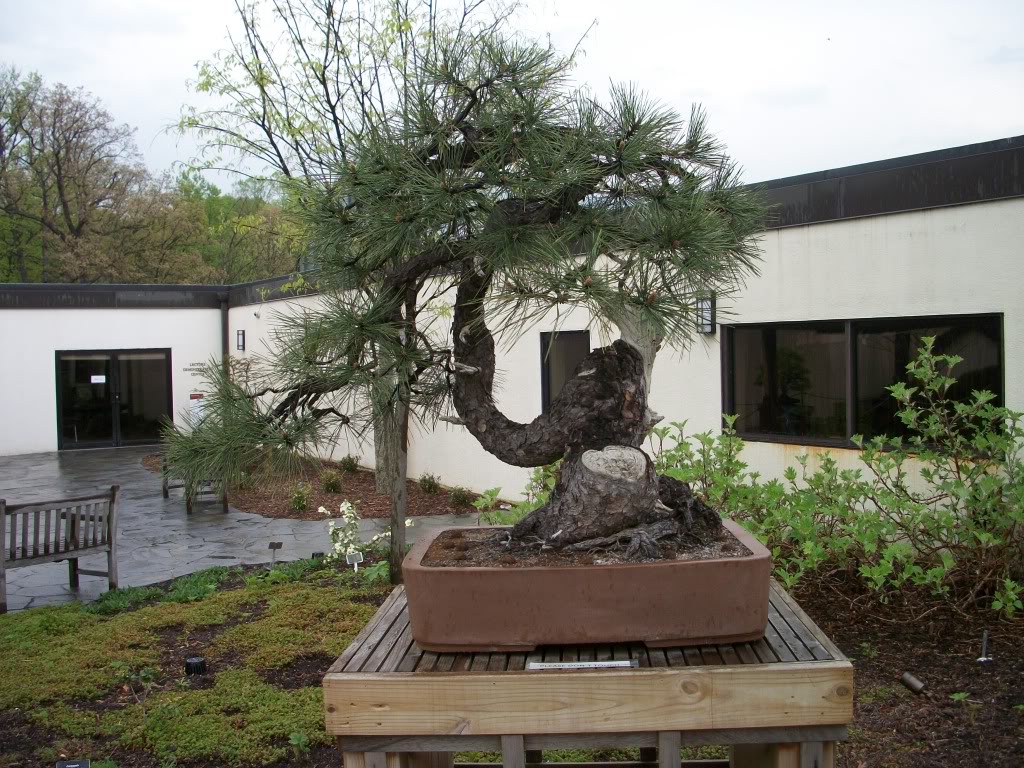
xuan le- Member
Page 1 of 2 • 1, 2 
 Similar topics
Similar topics» Do sycamores make good bonsai?
» Does Hebe make good bonsai material?
» would this stone make a good suiseki?
» Don't make a tree looked like a bonsai but make a bonsai looked like a tree - Revisit
» Ponderosa Pine at Bonsai Society of San Francisco 50th Ann.
» Does Hebe make good bonsai material?
» would this stone make a good suiseki?
» Don't make a tree looked like a bonsai but make a bonsai looked like a tree - Revisit
» Ponderosa Pine at Bonsai Society of San Francisco 50th Ann.
Page 1 of 2
Permissions in this forum:
You cannot reply to topics in this forum







